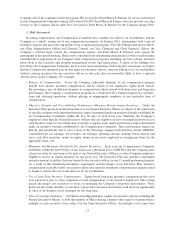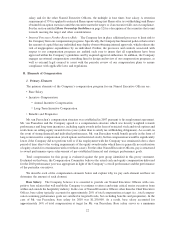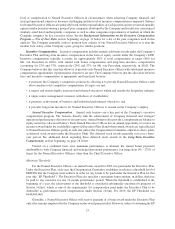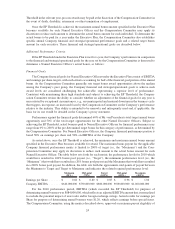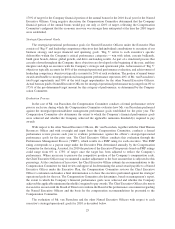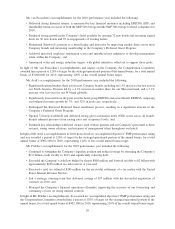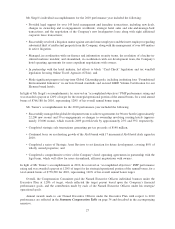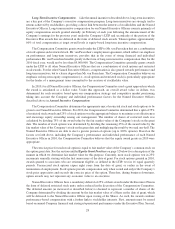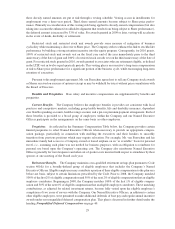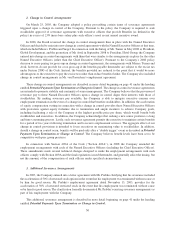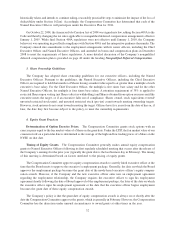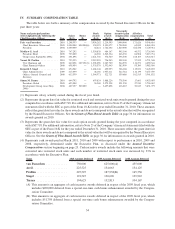Starwood 2010 Annual Report Download - page 40
Download and view the complete annual report
Please find page 40 of the 2010 Starwood annual report below. You can navigate through the pages in the report by either clicking on the pages listed below, or by using the keyword search tool below to find specific information within the annual report.Long-Term Incentive Compensation. Like the annual incentives described above, long-term incentives
are a key part of the Company’s executive compensation program. Long-term incentives are strongly tied to
returns achieved by stockholders, providing a direct link between the interests of stockholders and the Named
Executive Officers. Long-term incentive compensation for our Named Executive Officers consists primarily of
equity compensation awards granted annually (in February of each year following the announcement of the
Company’s earnings for the previous year) under the Company’s LTIP and secondarily of the portion of the
Executive Plan awards that are deferred in the form of deferred stock awards. Taken together, approximately
60% of total compensation at target award levels is equity-based long-term incentive compensation.
The Compensation Committee grants awards under the LTIP to Mr. van Paasschen that are a combination
of stock options and restricted stock. Mr. van Paasschen’s employment agreement, which reflects an emphasis
on performance and long-term incentives, provides that in the event of strong financial and individual
performance Mr. van Paasschen benefits greatly in the form of long-term incentive compensation that, for the
2010 fiscal year, would not be less than $5,000,000. The Compensation Committee generally grants awards
under the LTIP to all other Named Executive Officers that are a combination of stock options and restricted
stock awards. For the other Named Executive Officers, compensation is also geared towards performance and
long-term incentives, but to a lesser degree than Mr. van Paasschen. The Compensation Committee believes an
emphasis on long-term equity compensation (i.e., stock options and restricted stock) is particularly appropriate
for the leader of a management team committed to the creation of stockholder value.
In 2010, for all Named Executive Officers, the Compensation Committee used a grant approach in which
the award is articulated as a dollar value. Under this approach, an overall award value, in dollars, was
determined for each executive based upon our compensation strategy and competitive market positioning
taking into account the Company and individual performance factors for the Named Executive Officers
described above in Annual Incentive Compensation.
The Compensation Committee determines the appropriate mix of restricted stock and stock options to be
given to our Named Executive Officers. For 2010, the Compensation Committee determined that a split of 75%
of restricted stock awards and 25% of stock options was the appropriate balance to maximize cost effectiveness
and encourage equity ownership among our management. The number of shares of restricted stock was
calculated by dividing 75% of the award value by the fair market value of the Company’s stock on the grant
date. The number of stock options was determined by dividing the remaining 25% of the award value by the
fair market value of the Company’s stock on the grant date and multiplying the result by two and one-half. The
Named Executive Officers are able to elect a greater portion of options (up to 100% options). Based on the
factors set forth above, including the Company’s performance and individual performance of each Named
Executive Officer in 2010, the Compensation Committee believes that the equity award grants in 2010 were
appropriate.
The exercise price for each stock option is equal to fair market value of the Company’s common stock on
the option grant date. See the section entitled Equity Grant Practices on page 32 below for a description of the
manner in which we determine fair market value for this purpose. Currently, most stock options vest in 25%
increments annually starting with the first anniversary of the date of grant. For stock options granted in 2010,
awards granted to associates who are retirement eligible, as defined in the LTIP, vest in 16 equal quarterly
periods. Unexercised stock options expire eight years from the date of grant, or earlier in the event of
termination of employment. Stock options provide compensation only when vested and only if the Company’s
stock price appreciates and exceeds the exercise price of the option. Therefore, during business downturns,
option awards may not represent any economic value to an executive.
Named Executive Officers have a mandatory deferral of 25% of their awards under the Executive Plan in
the form of deferred restricted stock units, unless reduced in the discretion of the Compensation Committee.
The deferred amount (as increased as described below) is deemed to represent a number of shares of the
Company determined by dividing the amount by the fair market value of a Share on the date of grant, which
will be delivered to the Named Executive Officer upon vesting of the Shares. As such, the awards combine
performance-based compensation with a further link to stockholder interests. First, amounts must be earned
based on annual Company financial and strategic/operational performance under the Executive Plan. Second,
28





